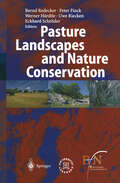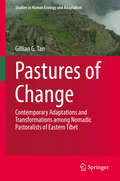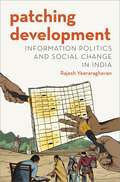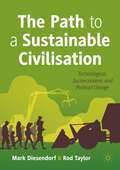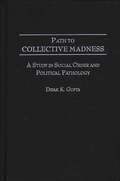- Table View
- List View
PASTORS & PUBLIC LIFE C: The Changing Face of American Protestant Clergy
by Corwin E. SmidtAmerica's clergy are not just religious leaders. Their influence extends far beyond church doors. Houses of worship stand at the center of American civic life-one of the few spheres in which relatively diverse individuals gather together regularly. And the moral authority granted to pastors means that they are uniquely positioned to play a role in public debates. Based on data gathered through national surveys of clergy across four mainline Protestant (the Disciples of Christ; the Presbyterian Church, USA; the Reformed Church in America; and the United Methodist Church) and three evangelical Protestant denominations (the Assemblies of God; the Christian Reformed Church; and, the Southern Baptist Convention), Pastors and Public Life examines the changing sociological, theological, and political characteristics of American Protestant clergy over the past twenty-plus years. Smidt focuses on the relationship between clergy and politics-clergy positions on issues of American public policy, norms on what is appropriate for clergy to do politically, as well as the clergy's political cue-giving, their pronouncements on public policy, and political activism-and the impact these changes have on congregations and on American society as a whole. Pastors and Public Life is the first book to systematically examine such changes and continuity over time. It will be invaluable to scholars, students, pastors, and churchgoers.
Pasture Landscapes and Nature Conservation
by Bernd Redecker Eckhard Schröder Werner Härdtle Peter Finck Uwe RieckenOne of the main problems and aims of nature conservation in Europe is to protect semi-open landscapes. The development during the past decades is characterized by an ongoing intensivation of land use on the one hand, and an increasing number of former meadows and pastures lying fallow caused by changing economic conditions on the other hand. In several countries the estabishment of larger "pasture landscapes" with a mixed character of open grassland combined with shrubs and forests has been recognized as one solution to this problem. The book gives an overview of the European projects concerning to this topic - nature conservation policy and strategies, scientific results and practical experiences creating large scale grazing systems.
Pastures of Change: Contemporary Adaptations and Transformations among Nomadic Pastoralists of Eastern Tibet (Studies in Human Ecology and Adaptation #10)
by Gillian G. TanThis book offers a novel examination of socio-environmental change in a nomadic pastoralist area of the eastern Tibetan plateau. Drawing on long-term fieldwork that underscores an ethnography of local nomadic pastoralists, international development organisations, and Chinese government policies, the book argues that careful analysis and comparison of the different epistemologies and norms about "change" are vital to any critical appraisal of developments - often contested - on the grasslands of Eastern Tibet.Tibetan nomads have developed a way of life that is dependent in multiple ways on their animals and shaped by the phenomenological experience of mobility. These pastoralists have adapted to many changes in their social, political and environmental contexts over time. From the earliest historically recorded systems of segmentary lineage to the incorporation first into local fiefdoms and then into the Chinese state (of both Nationalist and Communist governments), Tibetan pastoralists have maintained their way of life, complemented by interactions with "the outside world".Rapid changes brought about by an intensification of interactions with the outside world call into question the sustained viability of a nomadic way of life, particularly as pastoralists themselves sell their herds and settle into towns. This book probes how we can more clearly understand these changes by looking specifically at one particular area of high-altitude grasslands in the Tibetan Plateau.
Patching Development: Information Politics and Social Change in India (Modern South Asia)
by Rajesh VeeraraghavanDiving into an original and unusually positive case study from India, Patching Development shows how development programs can be designed to work. How can development programs deliver benefits to marginalized citizens in ways that expand their rights and freedoms? Political will and good policy design are critical but often insufficient due to resistance from entrenched local power systems. In Patching Development, Rajesh Veeraraghavan presents an ethnography of one of the largest development programs in the world, the Indian National Rural Employment Guarantee Act (NREGA), and examines NREGA's implementation in the South Indian state of Andhra Pradesh. He finds that the local system of power is extremely difficult to transform, not because of inertia, but because of coercive counter strategy from actors at the last mile and their ability to exploit information asymmetries. Upper-level NREGA bureaucrats in Andhra Pradesh do not possess the capacity to change the power axis through direct confrontation with local elites, but instead have relied on a continuous series of responses that react to local implementation and information, a process of patching development. "Patching development" is a top-down, fine-grained, iterative socio-technical process that makes local information about implementation visible through technology and enlists participation from marginalized citizens through social audits. These processes are neither neat nor orderly and have led to a contentious sphere where the exercise of power over documents, institutions and technology is intricate, fluid and highly situated. A highly original account with global significance, this book casts new light on the challenges and benefits of using information and technology in novel ways to implement development programs.
Patching Development: Information Politics and Social Change in India (Modern South Asia)
by Rajesh VeeraraghavanDiving into an original and unusually positive case study from India, Patching Development shows how development programs can be designed to work. How can development programs deliver benefits to marginalized citizens in ways that expand their rights and freedoms? Political will and good policy design are critical but often insufficient due to resistance from entrenched local power systems. In Patching Development, Rajesh Veeraraghavan presents an ethnography of one of the largest development programs in the world, the Indian National Rural Employment Guarantee Act (NREGA), and examines NREGA's implementation in the South Indian state of Andhra Pradesh. He finds that the local system of power is extremely difficult to transform, not because of inertia, but because of coercive counter strategy from actors at the last mile and their ability to exploit information asymmetries. Upper-level NREGA bureaucrats in Andhra Pradesh do not possess the capacity to change the power axis through direct confrontation with local elites, but instead have relied on a continuous series of responses that react to local implementation and information, a process of patching development. "Patching development" is a top-down, fine-grained, iterative socio-technical process that makes local information about implementation visible through technology and enlists participation from marginalized citizens through social audits. These processes are neither neat nor orderly and have led to a contentious sphere where the exercise of power over documents, institutions and technology is intricate, fluid and highly situated. A highly original account with global significance, this book casts new light on the challenges and benefits of using information and technology in novel ways to implement development programs.
Patchwork Leviathan: Pockets of Bureaucratic Effectiveness in Developing States
by Erin Metz McDonnellCorruption and ineffectiveness are often expected of public servants in developing countries. However, some groups within these states are distinctly more effective and public oriented than the rest. Why? Patchwork Leviathan explains how a few spectacularly effective state organizations manage to thrive amid general institutional weakness and succeed against impressive odds. Drawing on the Hobbesian image of the state as Leviathan, Erin Metz McDonnell argues that many seemingly weak states actually have a wide range of administrative capacities. Such states are in fact patchworks sewn loosely together from scarce resources into the semblance of unity.McDonnell demonstrates that when the human, cognitive, and material resources of bureaucracy are rare, it is critically important how they are distributed. Too often, scarce bureaucratic resources are scattered throughout the state, yielding little effect. McDonnell reveals how a sufficient concentration of resources clustered within particular pockets of a state can be transformative, enabling distinctively effective organizations to emerge from a sea of ineffectiveness.Patchwork Leviathan offers a comprehensive analysis of successful statecraft in institutionally challenging environments, drawing on cases from contemporary Ghana and Nigeria, mid-twentieth-century Kenya and Brazil, and China in the early twentieth century. Based on nearly two years of pioneering fieldwork in West Africa, this incisive book explains how these highly effective pockets differ from the Western bureaucracies on which so much state and organizational theory is based, providing a fresh answer to why well-funded global capacity-building reforms fail—and how they can do better.
Patchwork Nation: Sectionalism and Political Change in American Politics
by James Graydon Gimpel Jason E. SchuknechtThe unprecedented geographic and socioeconomic mobility of twentieth-century America was accompanied by a major reshuffling of political support in many parts of the country. Yet at the dawn of the new century these local and regional movements are still poorly understood. How can we account for persistent political regionalism and the sectional changes that have radically altered the nation's political landscape, from the Sun Belt to the Rust Belt? Patchwork Nation retrieves this lost knowledge, restoring geography to its central role in our nation's political behavior. "A primer on the importance of regional identity in the electoral system. ... [A]nyone interested in learning more about how America's diversity drives its political systems would do well to take a spin through Patchwork Nation." ---Meg Kinnard, NationalJournal.com "Location, location, location. What matters in politics is not just who the voters are, but where they are. Just ask Al Gore. Or read this book, a compelling demonstration that geography is often destiny." ---Bill Schneider, Senior Political Analyst, CNN "This accessible and well-written book challenges us to reflect on the role that political context plays in shaping the vote. By tracing how regional politics evolves over time within and across states, Gimpel and Schuknecht have revived the important but often neglected field of political geography." ---Donald Green, Yale University "In the spirit of V. O. Key, Gimpel and Schuknecht make a fundamental contribution. They demonstrate that states and regions are not simply important as units of aggregation, but rather as complex political arenas with profound consequences for processes of democratic politics both within and beyond their boundaries." ---Robert Huckfeldt, University of California, Davis
The Patent Crisis and How the Courts Can Solve It
by Dan L. Burk Mark A. LemleyPatent law is crucial to encourage technological innovation. But as the patent system currently stands, diverse industries from pharmaceuticals to software to semiconductors are all governed by the same rules even though they innovate very differently. The result is a crisis in the patent system, where patents calibrated to the needs of prescription drugs wreak havoc on information technologies and vice versa. According to Dan L. Burk and Mark A. Lemley in The Patent Crisis and How the Courts Can Solve It, courts should use the tools the patent system already gives them to treat patents in different industries differently. Industry tailoring is the only way to provide an appropriate level of incentive for each industry. Burk and Lemley illustrate the barriers to innovation created by the catch-all standards in the current system. Legal tools already present in the patent statute, they contend, offer a solution—courts can tailor patent law, through interpretations and applications, to suit the needs of various types of businesses. The Patent Crisis and How the Courts Can Solve It will be essential reading for those seeking to understand the nexus of economics, business, and law in the twenty-first century.
The Patent Crisis and How the Courts Can Solve It
by Dan L. Burk Mark A. LemleyPatent law is crucial to encourage technological innovation. But as the patent system currently stands, diverse industries from pharmaceuticals to software to semiconductors are all governed by the same rules even though they innovate very differently. The result is a crisis in the patent system, where patents calibrated to the needs of prescription drugs wreak havoc on information technologies and vice versa. According to Dan L. Burk and Mark A. Lemley in The Patent Crisis and How the Courts Can Solve It, courts should use the tools the patent system already gives them to treat patents in different industries differently. Industry tailoring is the only way to provide an appropriate level of incentive for each industry. Burk and Lemley illustrate the barriers to innovation created by the catch-all standards in the current system. Legal tools already present in the patent statute, they contend, offer a solution—courts can tailor patent law, through interpretations and applications, to suit the needs of various types of businesses. The Patent Crisis and How the Courts Can Solve It will be essential reading for those seeking to understand the nexus of economics, business, and law in the twenty-first century.
The Patent Crisis and How the Courts Can Solve It
by Dan L. Burk Mark A. LemleyPatent law is crucial to encourage technological innovation. But as the patent system currently stands, diverse industries from pharmaceuticals to software to semiconductors are all governed by the same rules even though they innovate very differently. The result is a crisis in the patent system, where patents calibrated to the needs of prescription drugs wreak havoc on information technologies and vice versa. According to Dan L. Burk and Mark A. Lemley in The Patent Crisis and How the Courts Can Solve It, courts should use the tools the patent system already gives them to treat patents in different industries differently. Industry tailoring is the only way to provide an appropriate level of incentive for each industry. Burk and Lemley illustrate the barriers to innovation created by the catch-all standards in the current system. Legal tools already present in the patent statute, they contend, offer a solution—courts can tailor patent law, through interpretations and applications, to suit the needs of various types of businesses. The Patent Crisis and How the Courts Can Solve It will be essential reading for those seeking to understand the nexus of economics, business, and law in the twenty-first century.
Patents for Power: Intellectual Property Law and the Diffusion of Military Technology
by Robert M. Farley Davida H. IsaacsIn an era when knowledge can travel with astonishing speed, the need for analysis of intellectual property (IP) law—and its focus on patents, trade secrets, trademarks, and issues of copyright—has never been greater. But as Robert M. Farley and Davida H. Isaacs stress in Patents for Power, we have long overlooked critical ties between IP law and one area of worldwide concern: military technology. This deft blend of case studies, theoretical analyses, and policy advice reveals the fundamental role of IP law in shaping how states create and transmit defense equipment and weaponry. The book probes two major issues: the effect of IP law on innovation itself and the effect of IP law on the international diffusion, or sharing, of technology. Discussing a range of inventions, from the AK-47 rifle to the B-29 Superfortress bomber to the MQ-1 Predator drone, the authors show how IP systems (or their lack) have impacted domestic and international relations across a number of countries, including the United States, Russia, China, and South Korea. The study finds, among other results, that while the open nature of the IP system may encourage industrial espionage like cyberwarfare, increased state uptake of IP law is helping to establish international standards for IP protection. This clear-eyed approach to law and national security is thus essential for anyone interested in history, political science, and legal studies.
Patents for Power: Intellectual Property Law and the Diffusion of Military Technology
by Robert M. Farley Davida H. IsaacsIn an era when knowledge can travel with astonishing speed, the need for analysis of intellectual property (IP) law—and its focus on patents, trade secrets, trademarks, and issues of copyright—has never been greater. But as Robert M. Farley and Davida H. Isaacs stress in Patents for Power, we have long overlooked critical ties between IP law and one area of worldwide concern: military technology. This deft blend of case studies, theoretical analyses, and policy advice reveals the fundamental role of IP law in shaping how states create and transmit defense equipment and weaponry. The book probes two major issues: the effect of IP law on innovation itself and the effect of IP law on the international diffusion, or sharing, of technology. Discussing a range of inventions, from the AK-47 rifle to the B-29 Superfortress bomber to the MQ-1 Predator drone, the authors show how IP systems (or their lack) have impacted domestic and international relations across a number of countries, including the United States, Russia, China, and South Korea. The study finds, among other results, that while the open nature of the IP system may encourage industrial espionage like cyberwarfare, increased state uptake of IP law is helping to establish international standards for IP protection. This clear-eyed approach to law and national security is thus essential for anyone interested in history, political science, and legal studies.
Patents for Power: Intellectual Property Law and the Diffusion of Military Technology
by Robert M. Farley Davida H. IsaacsIn an era when knowledge can travel with astonishing speed, the need for analysis of intellectual property (IP) law—and its focus on patents, trade secrets, trademarks, and issues of copyright—has never been greater. But as Robert M. Farley and Davida H. Isaacs stress in Patents for Power, we have long overlooked critical ties between IP law and one area of worldwide concern: military technology. This deft blend of case studies, theoretical analyses, and policy advice reveals the fundamental role of IP law in shaping how states create and transmit defense equipment and weaponry. The book probes two major issues: the effect of IP law on innovation itself and the effect of IP law on the international diffusion, or sharing, of technology. Discussing a range of inventions, from the AK-47 rifle to the B-29 Superfortress bomber to the MQ-1 Predator drone, the authors show how IP systems (or their lack) have impacted domestic and international relations across a number of countries, including the United States, Russia, China, and South Korea. The study finds, among other results, that while the open nature of the IP system may encourage industrial espionage like cyberwarfare, increased state uptake of IP law is helping to establish international standards for IP protection. This clear-eyed approach to law and national security is thus essential for anyone interested in history, political science, and legal studies.
Paternalism and Politics: The Revival of Paternalism in early Nineteenth-Century Britain (Studies in Modern History)
by Kim LawesThis book is about continuity and change in early nineteenth-century Britain. Against the background of an emerging industrial state, the popularization of liberal laissez-faire principles and the rise of a class-based society, it examines the revival of traditional paternal ideals and considers their influence upon the development of social policy. The poor laws, social distress, child labour and factory reform provide a focus for the analysis. The implications of the revival for the emergence of the collective or welfare state is an important theme.
Path Dependency and Macroeconomics (International Papers in Political Economy)
by Malcolm Sawyer P. ArestisThis fifth volume in the International Papers in Political Economy (IPPE) series focuses on the theme of path dependency and macroeconomics in terms of both theory and applications. The volume examines how path dependency is linked with notions of fundamental uncertainty, non-ergodicity and hysteresis.
The Path of a Genocide: The Rwanda Crisis from Uganda to Zaire
by Astri SuhrkeThe Great Lakes region of Africa has seen dramatic changes. After a decade of war, repression, and genocide, loosely allied regimes have replaced old-style dictatorships. The Path of a Genocide examines the decade (1986-97) that brackets the 1994 genocide in Rwanda. This collection of essays is both a narrative of that event and a deep reexamination of the international role in addressing humanitarian issues and complex emergencies.Nineteen donor countries and seventeen multilateral organizations, international agencies, and international nongovernmental organizations pooled their efforts for an in-depth evaluation of the international response to the conflict in Rwanda. Original studies were commissioned from scholars from Uganda, Rwanda, Zaire, Ethiopia, Norway, Great Britain, France, Canada, and the United States. While each chapter in this volume focuses on one dimension of the Rwanda conflict, together they tell the story of this unfolding genocide and the world's response.The Path of a Genocide offers readers a perspective in sharp contrast to the tendency to treat a peace agreement as the end to conflict. This is a detailed effort to make sense of the political crisis and genocide in Rwanda and the effects it had on its neighbors.
The Path of a Genocide: The Rwanda Crisis from Uganda to Zaire
by Astri SuhrkeThe Great Lakes region of Africa has seen dramatic changes. After a decade of war, repression, and genocide, loosely allied regimes have replaced old-style dictatorships. The Path of a Genocide examines the decade (1986-97) that brackets the 1994 genocide in Rwanda. This collection of essays is both a narrative of that event and a deep reexamination of the international role in addressing humanitarian issues and complex emergencies.Nineteen donor countries and seventeen multilateral organizations, international agencies, and international nongovernmental organizations pooled their efforts for an in-depth evaluation of the international response to the conflict in Rwanda. Original studies were commissioned from scholars from Uganda, Rwanda, Zaire, Ethiopia, Norway, Great Britain, France, Canada, and the United States. While each chapter in this volume focuses on one dimension of the Rwanda conflict, together they tell the story of this unfolding genocide and the world's response.The Path of a Genocide offers readers a perspective in sharp contrast to the tendency to treat a peace agreement as the end to conflict. This is a detailed effort to make sense of the political crisis and genocide in Rwanda and the effects it had on its neighbors.
The Path to a Modern Economics: Dealing with the Complexity of Economic Systems
by Henning SchwardtThis book illustrates how the treatment of complexity in analytical frameworks shapes economic studies. It explores the ways economists make sense of our economic environment and where their differences in interpretations of economic issues and policy proposals are rooted. Schwardt examines developments in economies and the role of the public sector over the last few centuries. Taking a theoretical approach and addressing different analytical frameworks, a basic distinction is introduced between top-down approaches, where assumptions about the economic environment are formulated at the outset; and bottom-up approaches, where an economic environment emerges from the interactions of the individual agents. By recognising the validity of alternate perspectives on economic issues, Schwardt proposes an improved foundation for economics research and policy.
The Path to a Modern Economics: Dealing with the Complexity of Economic Systems
by Henning SchwardtThis book illustrates how the treatment of complexity in analytical frameworks shapes economic studies. It explores the ways economists make sense of our economic environment and where their differences in interpretations of economic issues and policy proposals are rooted. Schwardt examines developments in economies and the role of the public sector over the last few centuries. Taking a theoretical approach and addressing different analytical frameworks, a basic distinction is introduced between top-down approaches, where assumptions about the economic environment are formulated at the outset; and bottom-up approaches, where an economic environment emerges from the interactions of the individual agents. By recognising the validity of alternate perspectives on economic issues, Schwardt proposes an improved foundation for economics research and policy.
The Path to a Sustainable Civilisation: Technological, Socioeconomic and Political Change
by Mark Diesendorf Rod TaylorThe Path to a Sustainable Civilisation shows that we have unwittingly fallen into an existential crisis of our own making. We have allowed large corporations, the military and other vested interests to capture governments and influence public opinion excessively. We have created a god called ‘the market’ and allowed our most important decisions to be made by this imaginary entity, which is in fact a human system controlled by vested interests. The result has been the exploitation of our life support system, our planet, and most of its inhabitants, to the point of collapse. This book argues that the way out of our black hole is to build social movements to apply overwhelming pressure on government and big business, weaken the power of vested interests and strengthen democratic decision-making. This must be done simultaneously with action on the specific issues of climate, energy, natural resources and social justice, in order to transition to a truly sustainable civilisation.
Path to Collective Madness: A Study in Social Order and Political Pathology
by Dipak K. GuptaWhy did the Rwandan genocide take place? How could parents feed their own children drinks laced with poison in Jonestown? As we see many parts of the world being engulfed in fratricidal frenzy, we wonder if it can happen in this country. Gupta examines contemporary cases of genocide and mass murder and seeks to explain why certain societies are more prone to these actions and others are relatively immune.Gupta sees a dialectical tension between our two identities: the self and the collective. The end of the medieval period was marked by the emergence of individualism in Europe. With time, the march of individualism engulfed the entire Western world and permeated every aspect of its culture, tradition, and academic paradigm. Neoclassical economics is the embodiment of this single-minded pursuit of the rationality of individualism. However, our psychobiological evolution has also imbued us with the irrepressible desire to form groups and to act upon its welfare. The reason for this eternal conflict lies in our own struggle with our two identities. When the pendulum swings to the extreme end of collectivism, genocide and other forms of social abnormalities--collective madness--occur. When we move too far into individualism, people tend to seek something greater beyond selfish pursuits. Through his panoramic view, Gupta provides an explanation for both social order and political pathology that will be of interest to students, scholars, and other researchers involved with ethnic conflict, collective behavior, and conflict resolution.
The Path to Democratic Reform: Bulgaria in Comparative Perspective (ISSN)
by Muzaffer KutlayThis book offers a comparative study of minority-majority relations in post-conflict societies. Drawing on three contentious cases – Bulgaria, Croatia, and Montenegro –it explores how pluralist governance structures are established in the area of minority rights in new EU member and candidate states and how reform resilience is ensured. The author shows the importance of cooperation and moderation between political elites in democratising countries, developing a comparative analysis of three understudied cases in the Balkans region and offering a conceptual framework based on extensive field research data and archive materials. Of great interest to both scholars and practitioners alike, this book identifies transferable policy lessons of interest to a global audience and specifies under which conditions substantial reforms should be carried out. It will appeal to a broad audience of students interested in international politics, European studies, state-mandated displacement, and ethnic studies.
The Path to Democratic Reform: Bulgaria in Comparative Perspective (ISSN)
by Muzaffer KutlayThis book offers a comparative study of minority-majority relations in post-conflict societies. Drawing on three contentious cases – Bulgaria, Croatia, and Montenegro –it explores how pluralist governance structures are established in the area of minority rights in new EU member and candidate states and how reform resilience is ensured. The author shows the importance of cooperation and moderation between political elites in democratising countries, developing a comparative analysis of three understudied cases in the Balkans region and offering a conceptual framework based on extensive field research data and archive materials. Of great interest to both scholars and practitioners alike, this book identifies transferable policy lessons of interest to a global audience and specifies under which conditions substantial reforms should be carried out. It will appeal to a broad audience of students interested in international politics, European studies, state-mandated displacement, and ethnic studies.
The Path to Mass Evil: Hannah Arendt and Totalitarianism Today
by Michael HardimanOn the Southern border of the United States in 2018, the decision was made to implement a separation policy among refugees and migrant families arriving at the border – and so a group of government employees left their homes, bidding farewell to their families as they went to work, and began to separate hundreds of children from their families, forcefully taking them to holding centres. Developing Hannah Arendt’s analysis of the banality of evil, The Path to Mass Evil demonstrates how the most educated, sophisticated and advanced societies in human history have the potential to descend into profound inhumanity and in the extreme can turn into enormous killing machines, implementing mass murder on a vast scale. Suitable for undergraduates and graduates in philosophy, sociology, psychology and religion, Michael Hardiman reveals how traditional understandings of morality fail to grasp how ordinary citizens become collaborators and engage in a range of levels of evildoing. He also highlights the necessity of confronting this evil in the increasingly divided and antagonistic world in which we find ourselves today.

